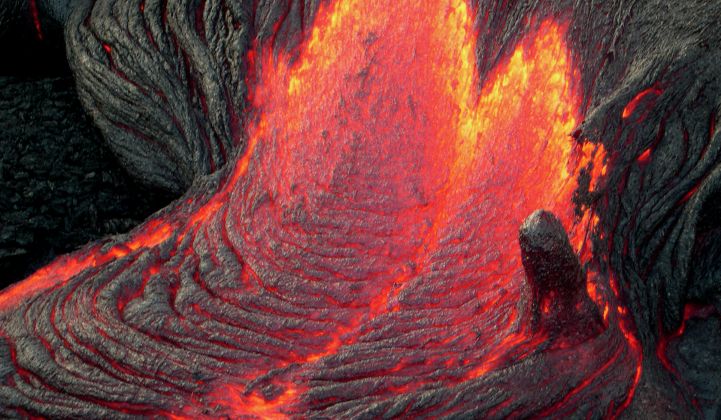Recent reports about tapping Icelandic volcanoes for power exports to the U.K. may have missed the point, say experts connected to the project.
Stories in mainstream media outlets such as The Guardian refer to a "geothermal project" -- but the work being carried out in Iceland is much, much different than traditional geothermal.
“What we’re trying to do is not geothermal energy,” said Professor Yan Lavallee, chair of volcanology and magmatic processes at the University of Liverpool’s Department of Earth, Ocean and Ecological Sciences. “It’s the most exciting thing since the moon [landing].”
The Krafla Magma Testbed project is looking to study, and possibly tap, the magma that sits several kilometers beneath the earth’s crust in numerous locations around the planet.
The project began after scientists discovered a magma chamber 2.1 kilometers under the Krafla volcano in northeast Iceland. This was far closer to the surface than predicted, said Lavallee.
The discovery prompted a rethink of whether near-surface magma pockets might be reachable elsewhere.
If a way is found to extract energy from the hot fluids near the surface of these magma wells, it could potentially provide power “in many countries” where volcanic activity is present, said Lavallee, including New Zealand, Japan, Mexico, Chile, Germany, Italy and France.
Such a prospect remains a long way off, however. For now, the University of Liverpool is among more than 25 scientific and research institutions working to set up the world’s first magma observatory at Krafla.
“The project is pushing us to derive supercritical heat from near magma systems in Iceland,” said Professor John Ludden, executive director of the British Geological Survey, which is acting as joint coordinator of the Krafla initiative, along with Iceland’s Geothermal Research Group.
“There is a more scientifically challenging part, which is to drill into magma to learn how to control eruptions and apply the results in places such as Naples or Mexico,” he said.
The good news is that when the Icelandic team hit magma under Krafla, in 2009, the borehole didn’t erupt. It was only the third time in human history that scientists had drilled down into this molten rock.
Another borehole near Krafla did result in a minor eruption in 1977. In 2005, the geothermal energy firm Ormat Technologies unexpectedly discovered magma while drilling a deep injection well in Puna, on the east of the island of Hawaii.
At Krafla, the magma itself is at a temperature above 850ºC. The fluids near it, which could provide supercritical heat for energy production, are at about 600ºC. This should be enough to deliver between five and 10 times more energy than traditional geothermal plants.
Getting that energy out would require a much better understanding of how magma works, which is a priority for the Krafla project. Scientists are to looking for funding to research the borehole and develop sensors that could probe magma’s mysteries.
The funding sums involved are not outrageous. Citing the British Geological Survey, Reuters reported that a first phase of the project, focusing on exploring the mechanism of eruptions, could start by 2020 at a cost of $30 million. Ludden put the figure closer to $25 million.
Setting up a magma observatory, meanwhile, could cost around $100 million upfront, and then $10 million per year for operation, said Lavallee. Work on how to commercially exploit magma for energy production would proceed alongside the scientific research, he said.
This means commercially available magma energy, if feasible at all, could be available as soon as a couple of decades from now. However, getting the energy off Iceland might be almost as hard as getting it out of the ground.
The obvious destination for Icelandic magma power is the U.K., which is already a major partner in the Krafla project because of its deep pool of volcanology expertise, and which has a growing need for baseload energy to replace aging coal-fired plants.
However, it would take an interconnector spanning more than 620 miles, the longest in the world, to reach the U.K.
What's more, the connector’s landing point would be the north of Scotland, where the U.K. grid is already struggling to cope with the output of a limited number of tidal turbines.
Such a cable, known as IceLink, has already been proposed at a cost of up to $3.9 billion, including onshore transmission network upgrades. That’s a lot of money, but still an order of magnitude less than the cost of building the U.K.’s Hinkley Point C 3.2-gigawatt nuclear reactor.
The output might be roughly the same. If magma power proves viable, said Ludden: “One could imagine 2 to 5 gigawatts coming to the U.K.”



